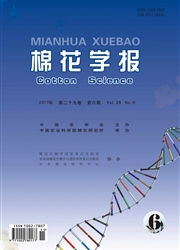

 中文摘要:
中文摘要:
叶片色素状况是评价植株光合能力、监测生长状况和预测产量潜力的重要指标,高光谱遥感技术为快速无损监测作物叶片色素提供了有效手段。本研究以4个棉花品种在3个施氮水平下的2年田间试验为基础,通过测定棉花(Gossypium hirsutum)功能叶片的高光谱反射率及对应的色素(叶绿素a、叶绿素b、叶绿素a+b、类胡萝卜素)含量,定量分析了叶片高光谱参数与色素含量之间的相关关系。结果表明,与棉花功能叶片各色素指标相关性比较好的高光谱波段主要分布在500~700nm;由敏感波段构建的光谱指数与各色素指标的相关性均在0.50以上;且红边最小值(Lo)可以作为共同的高光谱指数来估测不同棉花品种不同氮素水平下功能叶片的叶绿素总量(组合品种的R^2为0.67)。因此,通过高光谱参数来估算棉花功能叶片色素含量是可行的。
 英文摘要:
英文摘要:
Hyperspectral remote sensing is a powerful tool for non-destructively obtaining physiological and biochemical information in field crops. A vegetation index (VI) based on hyperspectral reflectance measures has been proposed as a reliable non-destructive method for quickly estimating pigment concentrations in cotton. To determine the best hyperspectral vegetation index for estimating pigment concentrations in cotton, canopy spectral reflectance (350~2500 nm) data of functional leaves at different growth stages of four cotton cultivars under three nitrogen levels were recorded with FieldSpec Pro FR radiometer in two field experiments, and the corresponding measures were taken on the concentrations of different pigments (chlorophyll a, chlorophyll b, chlorophyll a+b, and total carotenoid) in the functional leaves. Then the relationships of pigment concentrations to characteristics of hyperspectral reflectance in functional leaves were analyzed quantitatively. The results showed that the sensitive hyperspectral wavebands of leaf pigment concentrations in cotton were 550 ~ 700 nm. Vegetation indices composed of the sensitive wavebands were significantly correlated to the pigment concentrations in functional leaves, with the best vegetation index as the minimum value of red edge (Lo), R^2 value of 0.67 for all cultivars combined. Relationships of pigment concentrations to Lo can be potentially used for non-destructive and real-time monitoring of pigment concentrations in cotton leaves.
 同期刊论文项目
同期刊论文项目
 同项目期刊论文
同项目期刊论文
 期刊信息
期刊信息
